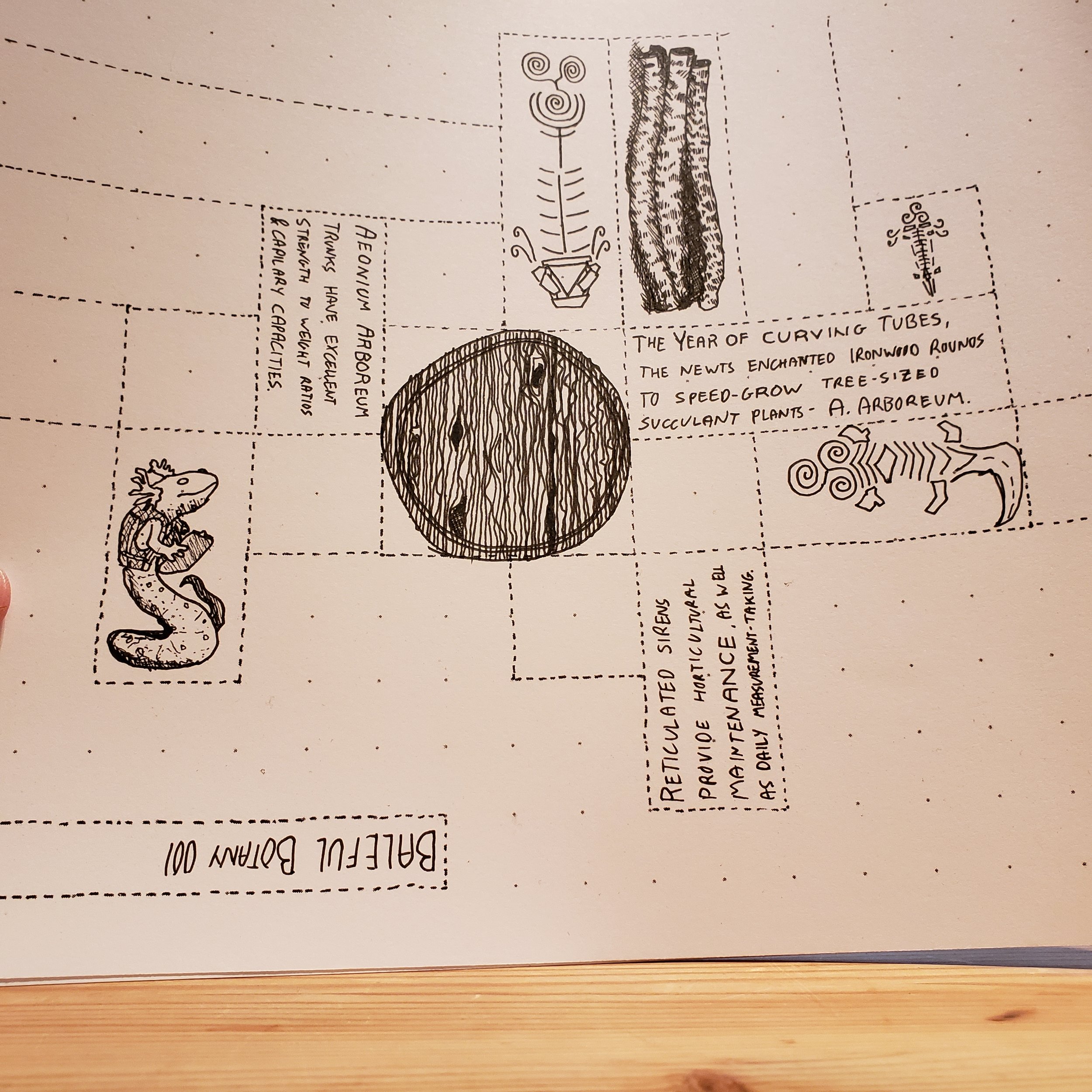Baleful Botany 001 - Aeonium Arboreum began on the Batteries to Bluffs trail in San Francisco, California. I hiked there in January 2019.
The trail is the westernmost in the Presidio, a former military fort, with hundreds of years of battlements, gun emplacements, and other harbor defence infrastructure. Once federal military land, It is now part of the Golden Gate National Recreation Area. It is thus managed by the National Park Service, not the City of San Francisco.
Battery Chamberlin, on Baker Beach, San Francisco, CA.
That trail winds upwards from beachside gun batteries on Baker Beach, an-ocean-facing beach a mile south of the Golden Gate Bridge. The trail climbs across a series of landslide-prone hillslopes, many of which feature deposits of serpentine, a greenish-blue rock of slippery and greasy feel. It is there and in nearby neighborhoods that one can find stands of the succulent plant Aeonium Arboreum, the ‘Irish Rose’.
The original reference photo. January 2019.
My goal was to recreate elements of that walk on paper, as a simplified &cartesian model of the landscapes I encountered. Standing in three dimensions over that map: the unique flora and fauna that flourish in it, starting with this Irish Rose.
My first sketches, soon after the initiating trail-walk. Thanks, Cam, for confirming the plant identification.
I outlined the layout in my journal the next day, and created a physical prototype a few weeks later. I got very lucky with the initial physical drawing - I moved quickly from pencil sketch to pen to scanned art layer to printed prototype, with little rework. Most of my time was spent on the digital side, lining pixels up and creating graphical cut-marks and trim-areas.
A few interlinked stands, atop a prototype map of the Forest of Woe, an infernal encounter space from Geoffrey Grabowski’s Dreams of Ruin book.
The penwork is all Micron Plastic Nib pens, in black. I worked in layers, moving from half-inch dot grid paper to blank tile templates, flipping back and forth between physical drawing and digital composition.
I built out seven different versions of the worksheet, each one from a different world. I called these ‘flavors’, a bit like an ice cream shop - one kind of product (ice cream) , with many different flavor options to choose from (chocolate, vanilla, cherry, etc.).
The idea was to reuse the folding plant artwork, with a few different bases, and surround it with unique and very different commentary, secondary illustration, creature tiles, botanical tags, and other ephemera.
The Newt Industry flavor features reticulated siren engineers monitoring the magical industrial farming of aeonium arboreum specimens, in service of their annual and ever-changing festival calendar, the Liturgical Industrial Egg Ritual. Here, I drew the secondary art and text separate from the plants themselves. I combined them digitally to create the final worksheets.
Each ‘flavor’ provided a different design constraint, and pushed me to work in a different direction.
Rampant Exofauna and Baleful Botany were the original two ideas - fantastical and science-fiction-appropriate terrain for tabletop roleplaying games, like Dungeons and Dragons, Gamma World, or Warhammer 40000. On a 1in:5ft grid, the plants are 20ft tall, twice the height of most adventurers, or space pirates. It was this use, as the highly visible centerpiece of a gaming table, which demanded the fold-and-seal format of the art: these plants must be viewable from all sides, with well-registered art.
I designed The Irish Rose of San Francisco for museum gift shops, park offices, school field trips, and other educational-and-fun needs. This version presents a variety of science and history facts about the species, suitable to encourage the intellectually curious to delve deeper into the field.
For our #instagram era, Paper Ritual combines #succulants, #papercraft, and #selfcare into one powerful worksheet.
A spiritual exploration, Jesus Loves an Irish Rose links the plant to the triskelion and the trinity.
A gothic, neo-victorian take, Dr Ward’s Vivarium presents the Irish Rose as a strange specimen gone wild with growth. Wardian Cases, briefcase-sized greenhouses for individual plant specimens, were an early form of terrarium.
Finally, Newt Industry presents the plants as part of a fantastical industrial ritual, with amphibian supervisors keeping careful track of magical growth rate.
Each flavor acted as another draft or test, and creating so many flavors honed the shared layout across all seven of them.
Draft of The Irish Rose of San Francisco
Draft of Paper Ritual
The grey guide marks were one of the many breakthroughs the iterative process allowed me to find. By cutting to the rectangular outline of each piece, then adhering the two sides, then trimming both sides of grey away, the end user keeps the art on each side correctly registered (lined up with its mirror), speeds up the assembly process, and gives additional visual assurance of correct cutting. Expect to see this method employed in future paper products.
To display the Irish Rose, I also created a paper greenhouse nook, based on Pittsburgh’s Phipps Conservatory.
Glass and Steel
Paper
Baleful Botany 001 - Aeonium Arboreum is available as a digital product you print at home, and as a physical product I send you in the mail.
I’m excited to explore modeling other plant species in paper. Expect more Baleful Botany in the future, especially if this one sells well!









